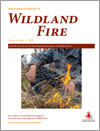International Journal of Wildland Fire
Volume 29
Number 11 2020
This review synthesises and discusses studies since 2006 that estimated the economic health cost from wildfire smoke exposure. We specifically focus on the functioning of the free tool BenMAP-CE from the Environmental Protection Agency that can be used to assess health cost from wildfires.
This study documents the goals of the Yunesit’in and Xeni Gwet’in First Nations as they develop fire management programs in central British Columbia, Canada. Three goals were identified from fire management: (1) strengthen cultural connection and well-being, (2) restore the health of the land and (3) respect traditional laws. These goals drive program evaluation.
Fire simulators inform critical decisions for communities during wildfires. The sensitivity of these models to input data uncertainty is unknown. Fire area is most sensitive to error in temperature and wind speed, whereas location is most sensitive to error in wind direction. On-ground intelligence is vital for accurate fire predictions.
We demonstrate the development of a burn severity atlas using Google Earth Engine (GEE) in a region with fire perimeters but no public severity mapping program. The automated (GEE) and manually produced maps from paired images corresponded to field measurements. We make the code and resulting burn severity atlas publicly available.
Wildfires in 2016 induced soil water repellency in broadleaf deciduous forests of the Blue Ridge Mountains, United States. One location had the greatest water repellency in surface ash, whereas three other locations had greatest repellency at the ash–mineral interface. Water repellency persisted for at least 1 year after the fires.
A hazard reduction burn in an endangered upland peat-forming swamp in eastern Australia did not cause ongoing changes to sediment microbial community or sediment properties 1 year after the fire.
Litterfall production and composition, fall pattern and nutrient content were studied in a mixed stand of Pinus nigra and Pinus pinaster (El Pozuelo), as well as in a pure stand of Pinus nigra (Beteta) in the Cuenca Mountains in order to determine the effect of two seasons of prescribed burning treatments.
Wildland fires can generate embers that can be lofted by the fire plume and initiate spot fires. This work seeks to elucidate factors that affect the characteristics of embers generated during the torching of several species of trees. It was observed that the number of embers generated is species-dependent.





